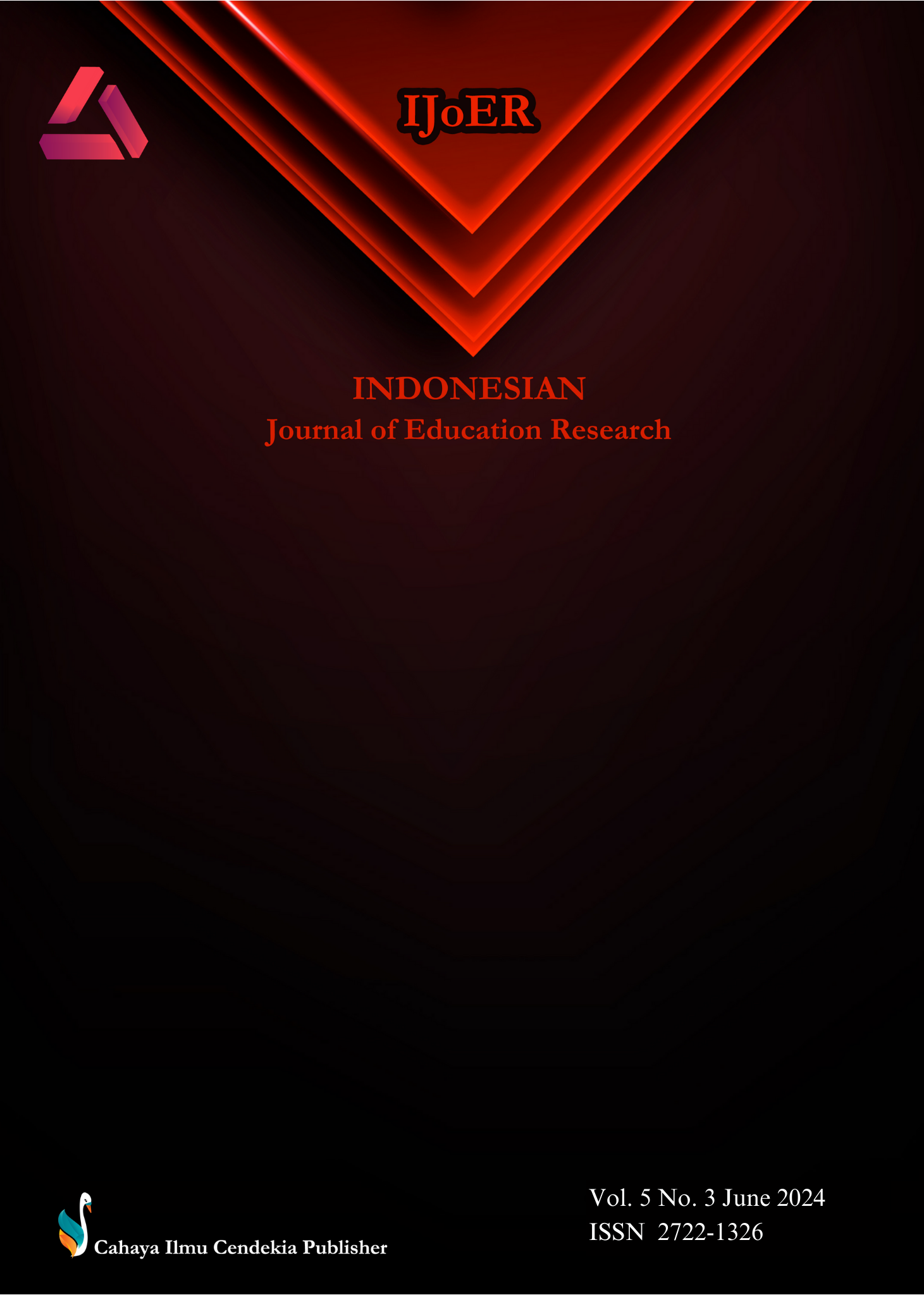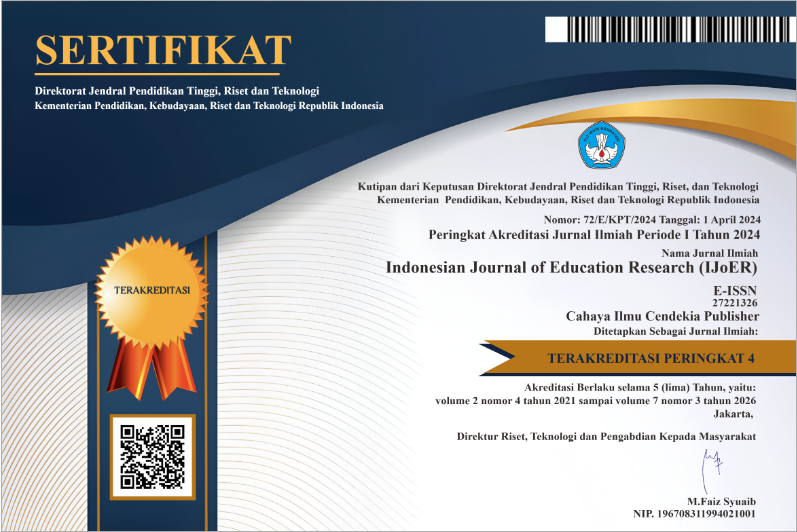Application of the Gagnon and Collay Model in Improving High School Students' Learning Outcomes in Biology Subjects
Abstract
Purpose of the study: This research aims to investigate the effectiveness of applying the Gagnon and Collay Model in improving Biology learning outcomes for class XI students at Public Senior High School 1 Bone-Bone, North Luwu Regency.
Methodology: This research is classroom action research which involves four components in each cycle. The research subjects consisted of 32 students of class XI Science 1 at Public Senior High School 1 Bone-Bone, North Luwu Regency. Data collection is carried out through tests and observation sheets in each cycle. Data analysis methods include qualitative and quantitative descriptive techniques.
Main Findings: From the analysis of student learning outcomes tests in each cycle, it can be observed that the abilities of class XI Science 1 students at Public Senior High School 1 Bone-Bone, North Luwu Regency, have increased. After implementing the Gagnon and Collay Learning Model, the students' average score increased from 63.5 in cycle I to 90.38 in cycle II. This shows an increase in biology learning outcomes after implementing the Gagnon and Collay Learning Model.
Novelty/Originality of this study: This research makes a significant contribution to the educational context by exploring and applying the Gagnon and Collay Model in improving student learning outcomes in Biology subjects. Through this approach, this research seeks to provide innovation in Biology teaching methods, aiming to create a learning environment that is more interactive, creative, and appropriate to the development of class XI Science 1 students.
References
M. Kustanto, "Social construction of education in beneficiary families of the Family Hope Program in Sidoarjo Regency," Sosio Conceptia , vol. 8, no. 3, pp. 267–286, 2019.
SW Oktavia, N. Septiani, F. Sinaga, and NN Qoidah, "Analysis of the Relationship in Learning Interest to Learning Outcomes Static Fluid Material in Senior High School," J. Ilm. Applied Science. Univ. Jambi , vol. 7, no. 1, pp. 22–26, 2023, doi: 10.22437/jiituj.v7i1.26696.
M. Choirudin, "Self-adjustment: as an effort to achieve mental well-being," Hisbah J. Bimbing. and Islamic Counseling , vol. 12, no. 1, pp. 1–20, 2015.
D. Purwanti and O. Farhurohman, "The Role of Citizenship Education in the Character Formation of Grade 5 and 6 Elementary School Students in Using Tiktok," Short. J. Educator. Character , vol. 4, no. 2, pp. 45–49, 2022, doi: 10.31764/cepatr.v4i2.6913.
L. Haqi, "The Influence of Communication Between Teachers and Students on the Learning Motivation of Class V Students at MI Matholi'ul Huda 02 Troso Jepara," Progr. Thesis. Stud. Educator. Madrasah Ibtidaiyah teacher, Univ. Walisongo State Islam , 2015.
W. Setiawan, "Effectiveness of Teacher Collaboration with Parents on Student Motivation and Learning Outcomes," GUAU J. Educator. Islamic Religion Teacher Profession , vol. 2, no. 2, pp. 163–180, 2022.
IK Sudarsana, "Optimizing the use of technology in curriculum implementation in schools (perspective of constructivism theory)," Cetta J. Educator Science. , vol. 1, no. 1, pp. 8–15, 2018.
WN Nasution, "Learning planning: definition, objectives and procedures," Ittihad J. Educator. , vol. 1, no. 2, pp. 185–195, 2017.
I. Farida, A. Afifah, D. Nurmalityari, and MA Naim, "Application of Islamic Mathematics Comics as an Effort to Improve Critical Thinking Abilities," J. Perelit. Class Actions , vol. 1, no. 1, pp. 11–17, 2023.
R. Rosalita, "Efforts to Improve Learning Outcomes of Life Organization Systems by Making Models of Plant/Animal Cell Structures Through Simple Educational Tools," J. Educator. Indonesia. , vol. 4, no. 9, pp. 996–1015, 2023, doi: 10.59141/japendi.v4i9.2224.
Y. Suryaningsih, "Practicum-Based Learning as a Means for Students to Practice Applying Science Process Skills in Biological Material," J. Bio Educ. , vol. 2, no. 2, pp. 49–57, 2017, doi: 10.24014/konfigurasi.v1i2.4537.
R. Darnella, S. Syarifah, and D. Afriansyah, "Application of the Concept Mapping Method and its Influence on Students' Critical Thinking Ability in Motion Systems Material at MAN 1 Palembang," J. Intelekt. Islam, Sos. and Science , vol. 9, no. 1, pp. 73–86, 2020, doi: 10.19109/intellectualita.v9i1.5579.
NW Damayanti, "The practice of providing scaffolding by mathematics education students in mathematics teaching and learning strategies (SBM) courses," J. Ilm. Fak. Miscarriage. And Educator Science. , vol. 18, no. 1, pp. 87–97, 2016, doi: 10.37303/likhitaprajna.v18i1.33.
RR Handoyo, "Analysis of Learning Theory in Braille Reading Teaching Methods for Blind Children," J. Stud. Teachers and Learning , vol. 5, no. 1, pp. 60–70, 2022, doi: 10.30605/jsgp.5.1.2022.1616.
AF Alhafid and D. Nora, "The contribution of parental social support and the role of peers to the sociology learning outcomes of class X and XI students at SMA Negeri 2 Bengkulu Selatan," J. Sikola J. Kaji. Educator. And Learning , vol. 1, no. 4, pp. 284–300, 2020.
DD Nurhidayati, "Increasing understanding of time management through group guidance with problem solving techniques for students," PSYCHOPEDAGOGIA J. Bimbing. And Counseling , vol. 5, no. 1, p. 24, 2016.
A. Astalini et al. , " Identification of Student Character Values in Class
ZZA Thaariq, R. Nurdiyanto, and D. Mariya Sulfa, "Problems in the Modern Science Learning Paradigm," J. Nyanadassana J. Researcher. Education, Social. and Religion , vol. 2, no. 2, pp. 112–121, 2023, doi: 10.59291/jnd.v2i2.38.
S. Syaparuddin, M. Meldianus, and E. Elihami, "Active learning strategies in increasing students' civics learning motivation," Mahaguru J. Educator. School Teacher. Basics , vol. 1, no. 1, pp. 30–41, 2020.
JP Casquilho, F. Sinaga, N. Septiani, SW Oktavia, NN Qoidah, and EFS Rini, "The Influence of Critical Thinking Ability on Students's Science Learning Outcomes," EduFisika J. Educator. Phys. , vol. 8, no. 2, pp. 116–124, 2023, doi: 10.59052/eduphysics.v8i2.24865.
Abdjul, D. "Penerapan model pembelajaran discovery learning untuk meningkatkan hasil belajar biologi pada siswa kelas X SMA negeri 1 Buntulia," Aksara: Jurnal Ilmu Pendidikan Nonformal, vol. 8, no. 1, pp. 343-348, 2022.
T. S. H. Noviyanto, B. H. Susanti, and S. Khairunnisa, "Penerapan model pembelajaran kooperatif tipe Make a Match untuk meningkatkan hasil belajar Biologi," Edukatif: Jurnal Ilmu Pendidikan, vol. 4, no. 1, pp. 572-581, 2022.
S. Karmiani, "Use of English comic media as an effort to improve English reading comprehension skills in class VIII students at SMPN 3 Teluk Kuantan," J. Pajar (Education and Teaching) , vol. 2, no. 6, pp. 883–890, 2018.
J. Junaini, MRM Rusdi, and M. Muslim, "Application of the problem based learning model to improve the mathematical argumentation skills of class X students at SMAN 2 Jambi City," PHI J. Educator. Matt. , vol. 4, no. 1, pp. 21–31, 2020, doi: 10.33087/phi.v4i1.82.
A. Suryana, I. Noviansyah, and F. Tamara, "The influence of audio-visual media on student learning achievement at Madrasah Ibtidaiyah Nurul Ilmi Citeureup Bogor," EduInovasi J. Basic Educ. Stud. , vol. 2, no. 2, pp. 112–132, 2022, doi: 10.47467/edui.v2i2.975.
Y. Kurniawan and A. Sudrajat, "The role of peers in forming the character of MTs (Madrasah Tsanawiyah) students," SOCIA J. Social Sciences. , vol. 14, no. 2, 2017, doi: 10.21831/socia.v14i2.17641.
FT Aldila, EFS Rini, SW Octavia, NN Khaidah, FP Sinaga, and N. Septiani, "The Relationship of Teacher Teaching Skills and Learning Interests of Physics Students of Senior High School," Eduphysics J. Pendidik. Phys. , vol. 8, no. 1, pp. 101–105, 2023, doi: 10.59052/eduphysics.v8i1.24864.
M. Wowor, JM Laoh, and DHC Pangemanan, "The relationship between knowledge and attitudes and exclusive breastfeeding for breastfeeding mothers at the Puskesmas Bahru, Manado City," J. Nursing , vol. 1, no. 1, 2013.
A. Astalini, D. Darmaji, DA Kurniawan, N. Septiani, and MZ Azzahra, "Revitalizing Science Education: Teachers' Response to Embedding Adat Bersendi Syara'and Syara'Bersendi Kitabullah Values into the Learning Process," Integr. Sci. Educ. J. , vol. 4, no. 3, pp. 117–122, 2023, doi: 10.37251/isej.v4i3.735.
ES Febriani, D. Arobiah, A. Apriyani, E. Ramdhani, and AS Millah, "Data Analysis in Classroom Action Research," J. Kreat. Ms. , vol. 1, no. 2, pp. 140–153, 2023.
M. Palyanti, "Fun and Fun Learning Media to Increase Student Learning Motivation in Indonesian Language Courses," Attract. Innov. Educ. J. , vol. 5, no. 2, pp. 1014–1026, 2023.
CAP Vercaruz, N. Septiani, and RS Fitriani, "Comparison of character responsibilities and learning outcomes in Mexico and Indonesia in first high schools," EduFisika J. Educator. Phys. , vol. 8, no. 2, pp. 183–196, 2023, doi: 10.59052/eduphysics.v8i2.26532.
Copyright (c) 2024 Anci Mariesi, Maryam Zand Vakili, Khder Niazi Nooraldeen Chalabi

This work is licensed under a Creative Commons Attribution 4.0 International License.
Authors who publish with this journal agree to the following terms:
- Authors retain copyright and acknowledge that the Indonesian Journal of Education Research (IJoER) is the first publisher licensed under a Creative Commons Attribution 4.0 International License.
- Authors are able to enter into separate, additional contractual arrangements for the non-exclusive distribution of the journal's published version of the work (e.g., post it to an institutional repository or publish it in a book), with an acknowledgment of its initial publication in this journal.
- Authors are permitted and encouraged to post their work online (e.g., in institutional repositories or on their website) prior to and during the submission process, as it can lead to productive exchanges and earlier and greater citation of published work.







.png)
.png)




















